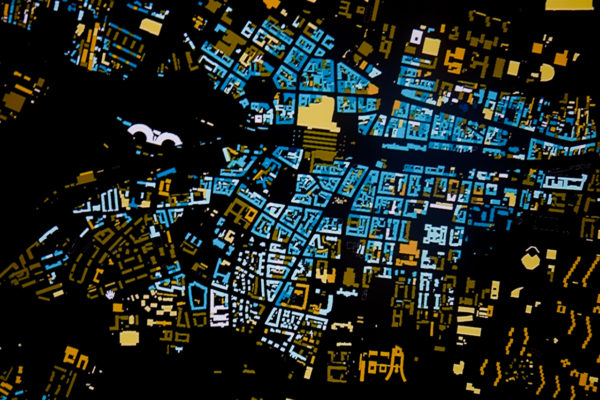The exhibition is the result of a Medialab Katowice educational and research project which consisted of several lectures and workshops conducted under the guidance of experienced designers. In formal terms, it refers to the activities of the Isotype Institute and the universal visual language created in Vienna in the 1920s. The exhibition is devoid of the traditional historical narrative, which usually puts the focus on important historical figures, political events or wars. Instead, it uses diagrams, maps and data visualisations to illustrate the rapid transformations of Katowice.
Katowice stands out from the rest of Poland as a city defined by great dynamism and constant need for change. The rhythm of the city’s history is marked by bold visions put forward in defiance of previous achievements. Once every few decades, Katowice reinvents itself: the boundaries are moved, existing built-up areas are redeveloped, the inhabitants and their customs change. This constant flux determines the landscape of the city and its multi-faceted identity.
The exposition is devoid of the traditional historical narrative, which usually puts the focus on important historical figures, political events or wars. Instead, it uses diagrams, maps and data visualisations to illustrate the rapid transformations of Katowice. The city’s architecture plays an important role, showing the momentum and optimism of its creators, regardless of the period and political context.
The exhibition is the result of a Medialab Katowice educational and research project which consisted of several lectures and workshops conducted under the guidance of experienced designers. The project included an interdisciplinary team, inter alia, cultural researchers, designers, architects and spatial planners.
Their task was not to create a universal and objective story about the city’s history, but to look at Katowice from a new perspective through the use of tools for data processing and visualisation.
In formal terms, the exhibition refers to the activities of the Isotype Institute and the universal visual language created in Vienna in the 1920s. Inspiration came particularly from a series of innovative museum exhibitions staged in Austria’s capital at that time, and also from Otto Neurath’s famed Modern Man in the Making (1939), a history book describing the story of mankind in an accessible way.
The studies presented by Medialab help tackle stereotypes and understand the current challenges facing Katowice, including the development of public spaces and quality of life in the city centre. In fact, the city’s history is just an excuse to consider the current status and future of Katowice.


